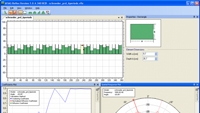Project studios get diffusion right with AFMG Reflex

German software developer AFMG has developed a new tool for designers and owners of project studios and home theaters. AFMG Reflex software models the reflection, diffusion and scattering of sound waves by geometrical structures. Reflex Basic owners can quickly and easily analyze both specialized diffusers and ordinary wall surfaces. Reflex Basic saves time and money by optimizing diffusing room treatments for small to midsized critical listening spaces. Users can quickly evaluate diffuser performance and fine-tune room design for both single-listener and expanded sweet spots.
“Diffusors can reduce standing waves and smooth out room response while keeping a live quality,” said AFMG’s Stefan Feistel. “But, they’re more expensive than simple absorption, and until AFMG Reflex, the results were extremely hard to predict.”
Although it is based on advanced algorithms, Reflex Basic makes design and optimization simple and easy. The user draws a 2-D cross section of the reflective surface. Reflex Basic then displays the reflective properties as a polar response graph for any frequency at any angle of incidence. Scattering and diffusion coefficients are shown as frequency response graphs. Different angles and frequencies can be compared and saved as a report. This makes it easy to optimize both the design and placement of diffusers in the room.
Along with Reflex Basic, AFMG has also introduced Reflex Standard, which has an unlimited feature set. The size and complexity of surfaces are unlimited: any 2-D-extruded geometrical surface design can be modeled, and users can view multiple surface models simultaneously for detailed comparison. AFMG Reflex Standard is an indispensable tool for calculating the scattering coefficients required for auralizations (audible previews of sound system performance and architectural acoustics) generated by the EASE module AURA. Both versions of Reflex will be available online.
The professional video industry's #1 source for news, trends and product and tech information. Sign up below.
